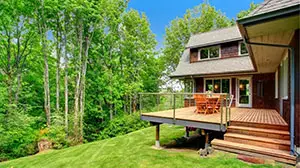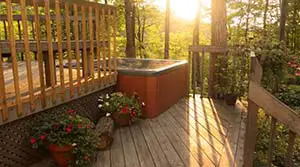
Spending time outside on your deck can make for a relaxing summer. It can be even more comfortable if you add a hot tub to the mix.
A hot tub relaxes the body with the heat by widening blood vessels, allowing blood to move freely throughout your body.
It can relieve stress on painful and swollen joints and help alleviate swelling and loosen sore muscles. The benefits of a hot tub are numerous, but if installed on a deck without adequate support, you could be in for some trouble.
To reinforce a deck for a hot tub, you will need to add additional support, including adding to current beams and doubling up joists.
More footings and posts are required when the bearing load above the deck is under 100 pounds per square foot. The hot tub will need more support as the height of the deck goes up.
This article will look at different methods of reinforcing a deck for a hot tub, with recommendations on tools, material, and if you should consult a structural engineer.
Before starting any construction project, you need to check with your local building office for code compliance.
Can I Put a Hot Tub on Decking?
Placing a hot tub on deck boards is acceptable as it is a stable flat surface. A hot tub does require a durable surface to sit on. The sturdy veneer can be concrete, wood, composite, or compacted soil with crushed gravel.
Advancements in composite decking make for very sturdy and durable decking material. One of the more popular composite decking called Trex Transcend rates at 872 pounds per square foot, which is more than adequate to carry the weight of a hot tub. Make sure that you follow the decking manufacturer’s recommended framing requirements.
Best Place to Put the Hot Tub
With all things considered, a hot tub can sit on a wood deck, but the absolute best place to put a hot tub is on a 4-inch thick concrete slab. You can always build a deck around the hot tub, giving you a wonderful place to spend time relaxing.
Pre-plan Where the Hot Tub Goes
Pre-planning where to put your hot tub is a crucial step, and you should take careful consideration. Before deciding, you should consider a few things:
- The flow of movement on your deck
- Where the electric service is at
- How your deck is supported
Consult an Engineer
For best results and your safety, it’s wise to consult a qualified structural engineer to inspect your deck where you plan to place the hot tub.
This consultation will be well worth the fee instead of a deck catastrophe causing bodily harm or death. Hiring an engineer will give you a lot of insight and maybe answer some other questions about the structure of your deck.
How Do You Determine If a Deck Can Support a Hot Tub?
Although most decks can support a hot tub, there are still exceptions to the rule. If you notice the following on your deck, you might want to consider placing the hot tub in a different area:
1. Dry Rot
Dry rot on a deck is authentic and can wreak havoc if you do not take steps to prevent it. Some sure signs that dry rot sets in are long grayish mold sheets or areas with pest damage.
Other damage indicators to your deck are easily identifiable by probing around the frame and deck boards for soft spots. You have advanced dry rot on your deck if you can quickly sink a probe into the wood.
2. Signs of Deterioration in the Ledger Board
Take extra time to inspect the ledger board if your deck connects to your home. The ledger board is load-bearing and an essential part of the deck.
Check for flashing or lack of flashing on the ledger as this is the most common reason for deck collapse is a rotten ledger board.
3. Deck Indentations
If your deck already has indentations, it may worsen if you place a hot tub on it. Keep in mind that the weight of a hot tub can exceed more than 4000 pounds.
If your deck has indentations with lighter objects or people, placed, or moving around on it, how much more if you place a thousand-pound hot tub. Depending on the age, decking can indent from the weight of a hot tub, especially if exposed to excessive heat.
Do You Need to Reinforce a Deck for a Hot Tub?
If you have a standard deck, you will have to reinforce it to carry the increased load. Residential building code requires that a deck needs to support a minimum of 40 pounds per square foot of live load.
Considering that a small 8ft x 8ft hot tub with water weighs about 5000 pounds, it will give you nearly 100 pounds per square foot.
A standard attached deck uses a ledger board connected to the house’s rim joist. If the ledger board is connected correctly, you can add extra lags to secure it even further, and it will support the weight of a hot tub. You will still need to assess the remainder of the deck to keep the poundage of a hot tub.
Now, what if your deck is old? Do you need to replace it before putting a hot tub on it, or is reinforcement enough?
Just because a deck is old does not mean it’s in bad shape. If your old deck is attached to your home by a ledger board, you will need additional support posts and a beam to carry the extra load of the hot tub.
Inspect your deck for decay and rot around the support posts at the ledger board connection, and check the top of the joists for rot. If your old deck shows signs of corrosion or decay, then yes, you will need to replace it before you attempt to put a hot tub on top.
How Do I Reinforce a Deck for a Hot Tub?
Before reinforcing your deck, it is essential to prepare the materials and tools you need. Having the right tools can significantly reduce the difficulty of strengthening your patio for a hot tub. Most of the tools are common, and you might already have them in your toolbox.
Here is a list of tools that will make reinforcing your deck easier:
- 18-volt or larger drill
- Socket set
- Circular saw
- Compound miter saw
- Tape measure
- Deck board bender/pry bar
- Claw hammer
- Round point shovel
- Post hole diggers
- Reciprocating saw
- Chalk box
- Framing and speed squares
- Pneumatic palm nailer
- Level
Once you have these tools handy, the next step is to follow this guide to strengthen your deck for your hot tub.
- Add extra support posts and footings to accommodate for the excess weight of the hot tub. It is recommended to use a minimum of a 6×6 support post up to 6 feet above grade, then 8×8 supports over 6 feet high.
- Double up the joists below where the hot tub will be sitting. Installing extra joists next to the existing joists is called “sistering.” This sistering of the deck joists will double the deck’s load capacity. For example, if your deck is built for 50 pounds per square foot, sistering the joists can bring it up to 100 pounds per square foot.
- Building a new deck to support the weight of a hot tub, install the deck joists at 12 inches on center.
- Add additional blocking between the joists to support the deck from swaying with the hot tub on top.
- Install sway bracing between the support posts to prevent the deck from moving horizontally.
Is It Worth Putting a Hot Tub on a Deck?
Hydrotherapy dates back thousands of years, and studies are linking it to joint pain relief, increased blood flow, and even better sleep. Most of all, sitting in a hot tub will help you relax after a long day, or even a short one.
The top reason to put a hot tub on your deck is that they are fun! You can have fun with your family and friends spending quality time in your new hot tub.
To make it worth it, and for both your deck and hot tub to last for a long time, preventive measures and maintenance should be part of your plan.
You also need to consider what type of material your hot tub and deck are made of. Here are a few tips you can take note of:
- Due to its porous nature, wood will soak up any water that spills over the sides and will rot over time if it continues. Composite is also porous but can withstand water rot better than wood.
The best decking material to put a hot tub on is PVC decking, which is a more significant investment upfront. Still, in the end, it will last longer.
- When working on a deck, it is tempting to use 16d nails that you might have in your garage, but they are not adequate or recommended fasteners especially if your deck is made of treated lumber.
You can use nails, but we recommend using double-dipped galvanized to provide better protection and lasting power of the nail.
- Lighting is not required but should be considered if you will regularly use your hot tub during night time. Spotlights are common and can be attached to a nearby tree, pergola, or your house.
Motion sensor lights are also a good idea because the light turns on when you need it most. Having solar power lights will go even further to help reduce your electricity bill while still having proper lighting on your deck.
- When working with lumber, especially treated ones, always wear a dust mask when cutting the lumber, as the dust can carry a lot of harmful chemicals you don’t want in your lungs.
Wear gloves to avoid getting the chemicals on your hands. Make sure to wash your hands thoroughly right after.
- Make sure to dispose of the sawdust and scrap materials according to local regulations. Never burn treated lumber as it will release harmful toxins and pollute the air.
Conclusion
All in all, putting a hot tub on a deck is a great idea and highly recommended if your deck can support the additional weight. If you follow the tips in this article to beef up your deck, you will enjoy your relaxing hot tub for years to come.
Sources













